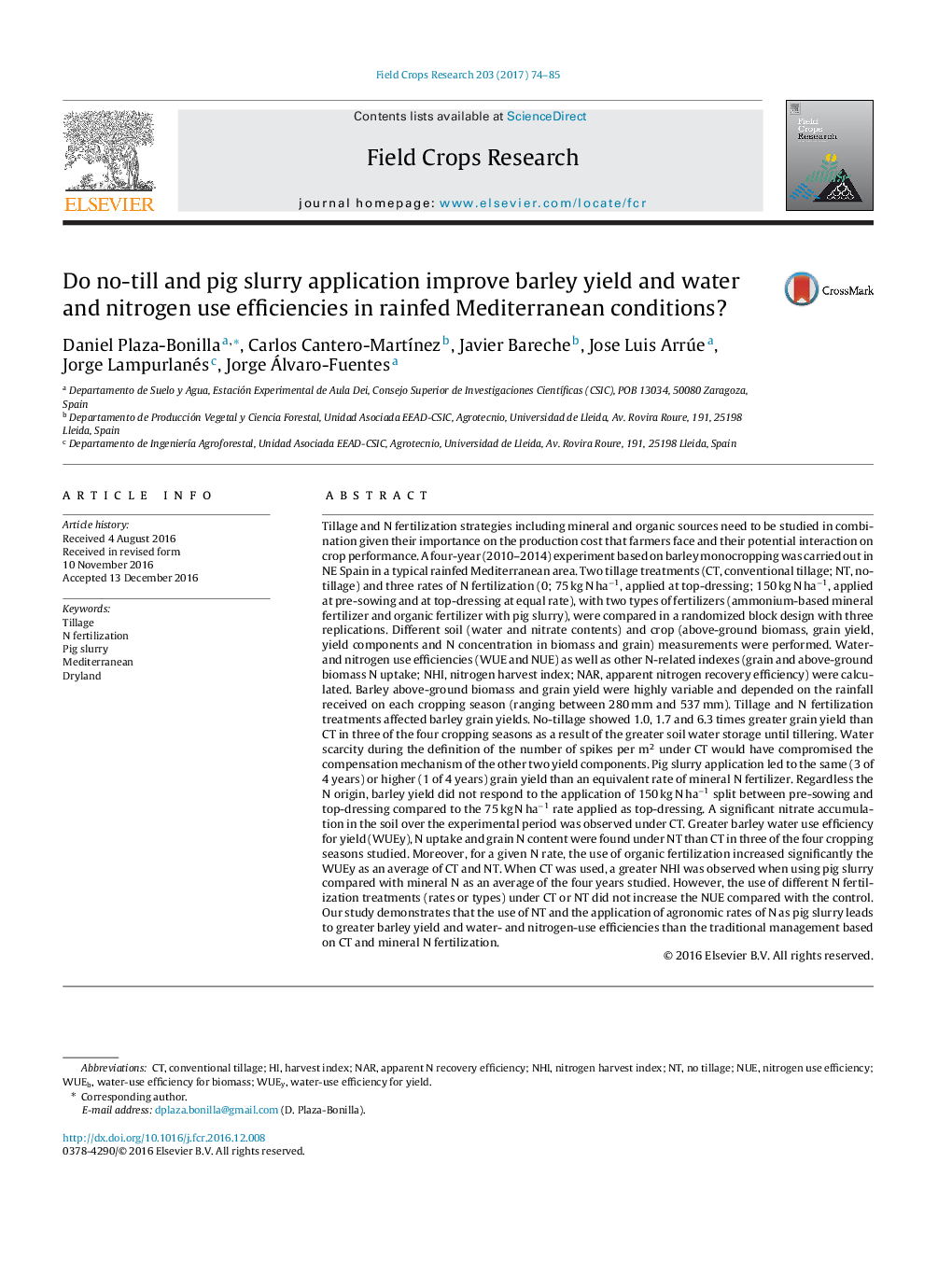| کد مقاله | کد نشریه | سال انتشار | مقاله انگلیسی | نسخه تمام متن |
|---|---|---|---|---|
| 5761467 | 1624660 | 2017 | 12 صفحه PDF | دانلود رایگان |
عنوان انگلیسی مقاله ISI
Do no-till and pig slurry application improve barley yield and water and nitrogen use efficiencies in rainfed Mediterranean conditions?
ترجمه فارسی عنوان
آیا استفاده از دوغاب بدون خمیر و خوک را بهبود عملکرد جو و استفاده از آب و نیتروژن در شرایط آب و هوایی مدیترانه ای؟
دانلود مقاله + سفارش ترجمه
دانلود مقاله ISI انگلیسی
رایگان برای ایرانیان
کلمات کلیدی
NUENARNHINitrogen use efficiency - استفاده از نیتروژن بهره وریN fertilization - باروری NNo tillage - بدون خاکریزیTillage - خاکورزی یا شخم یا پایکن Pig slurry - دوغاب خوکDryland - سرزمین خشکHarvest index - شاخص برداشتnitrogen harvest index - شاخص برداشت نیتروژنConventional tillage - شخم زدن معمولیMediterranean - مدیترانه
موضوعات مرتبط
علوم زیستی و بیوفناوری
علوم کشاورزی و بیولوژیک
علوم زراعت و اصلاح نباتات
چکیده انگلیسی
Tillage and N fertilization strategies including mineral and organic sources need to be studied in combination given their importance on the production cost that farmers face and their potential interaction on crop performance. A four-year (2010-2014) experiment based on barley monocropping was carried out in NE Spain in a typical rainfed Mediterranean area. Two tillage treatments (CT, conventional tillage; NT, no-tillage) and three rates of N fertilization (0; 75 kg N haâ1, applied at top-dressing; 150 kg N haâ1, applied at pre-sowing and at top-dressing at equal rate), with two types of fertilizers (ammonium-based mineral fertilizer and organic fertilizer with pig slurry), were compared in a randomized block design with three replications. Different soil (water and nitrate contents) and crop (above-ground biomass, grain yield, yield components and N concentration in biomass and grain) measurements were performed. Water- and nitrogen use efficiencies (WUE and NUE) as well as other N-related indexes (grain and above-ground biomass N uptake; NHI, nitrogen harvest index; NAR, apparent nitrogen recovery efficiency) were calculated. Barley above-ground biomass and grain yield were highly variable and depended on the rainfall received on each cropping season (ranging between 280 mm and 537 mm). Tillage and N fertilization treatments affected barley grain yields. No-tillage showed 1.0, 1.7 and 6.3 times greater grain yield than CT in three of the four cropping seasons as a result of the greater soil water storage until tillering. Water scarcity during the definition of the number of spikes per m2 under CT would have compromised the compensation mechanism of the other two yield components. Pig slurry application led to the same (3 of 4 years) or higher (1 of 4 years) grain yield than an equivalent rate of mineral N fertilizer. Regardless the N origin, barley yield did not respond to the application of 150 kg N haâ1 split between pre-sowing and top-dressing compared to the 75 kg N haâ1 rate applied as top-dressing. A significant nitrate accumulation in the soil over the experimental period was observed under CT. Greater barley water use efficiency for yield (WUEy), N uptake and grain N content were found under NT than CT in three of the four cropping seasons studied. Moreover, for a given N rate, the use of organic fertilization increased significantly the WUEy as an average of CT and NT. When CT was used, a greater NHI was observed when using pig slurry compared with mineral N as an average of the four years studied. However, the use of different N fertilization treatments (rates or types) under CT or NT did not increase the NUE compared with the control. Our study demonstrates that the use of NT and the application of agronomic rates of N as pig slurry leads to greater barley yield and water- and nitrogen-use efficiencies than the traditional management based on CT and mineral N fertilization.
ناشر
Database: Elsevier - ScienceDirect (ساینس دایرکت)
Journal: Field Crops Research - Volume 203, 1 March 2017, Pages 74-85
Journal: Field Crops Research - Volume 203, 1 March 2017, Pages 74-85
نویسندگان
Daniel Plaza-Bonilla, Carlos Cantero-MartÃnez, Javier Bareche, Jose Luis Arrúe, Jorge Lampurlanés, Jorge Álvaro-Fuentes,
